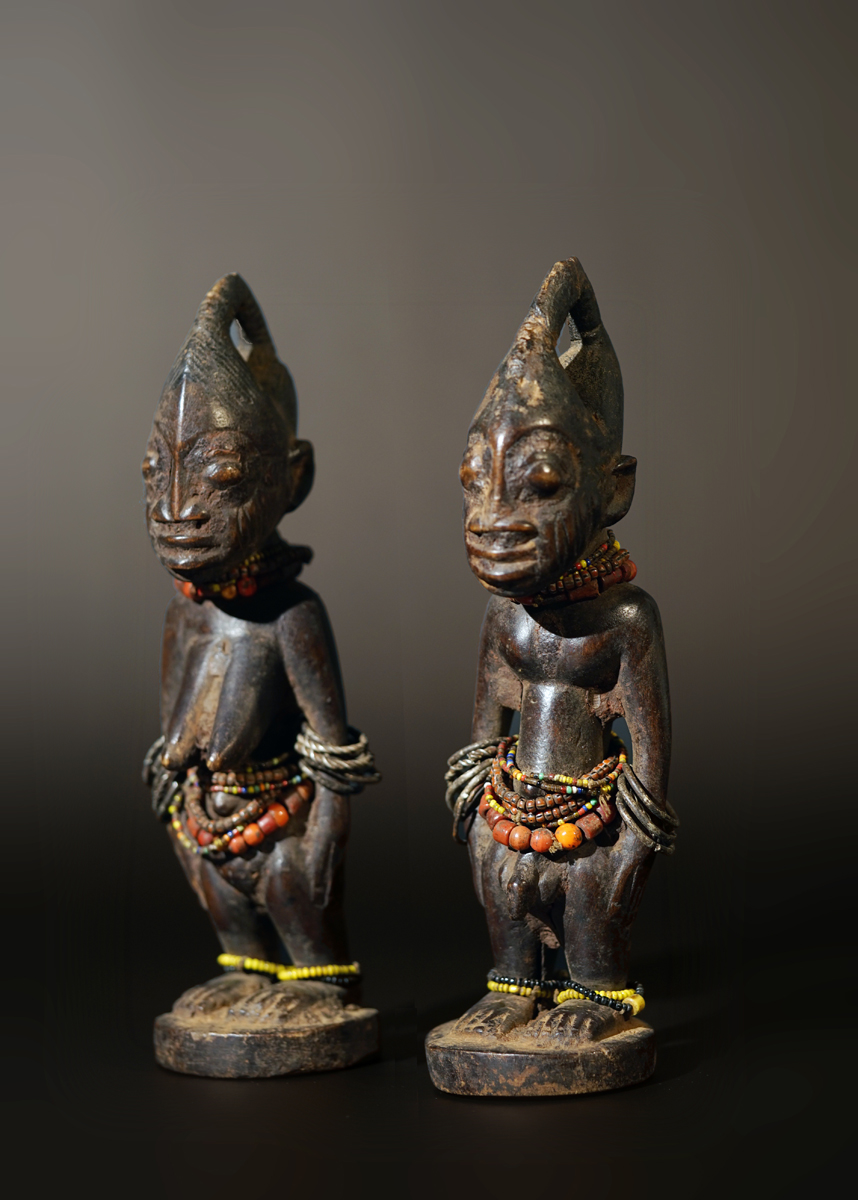 |
An Ere Ibeji couple, standing on flat round bases, both wear their hair in the same elaborately stylized coiffure. The blackened hair is divided in two parts which are separated in the middle of the scalp and come together again high above the head, forming a handle. The bodies are compact with short legs, the arms touch the thighs. Their eyes are big and round lying in incised circles causing an austere and somewhat astounded facial expression. The ears are likewise big and fleshy. Both have scarifications that reach from ears to eyes and stretch all over the cheeks. The fleshy slightly opened lips protrude the flat noses. Each figure perfectly matches its sculptural twin.They wear beads around neck, waist, arms and ancles;
Shiny brown patina. The colour is faded and rubbed off at the bases, arms and heads due to intensive use. The male figure´s coiffure has thin splits in the uppermost part and a hairline crack through the right side of the face and from the hip to the base. The female figure has a hairline crack from the left side of the back of the head to the pelvis and a crack in the back part of the base.
These carved wooden sculptures from West Africa represent the souls of deceased twins. ...These carvings are called ere ibeji (‘ere’ means sacred image, ‘ibi’, means born and ‘eji’ means two). The family look after this figure as if it were alive: feeding, bathing, clothing, carrying it like a baby, and performing rituals on significant occasions, to ensure the balance of the shared soul. These figures show evidence of the years of attention and care they have been given, their facial features worn smooth with the handling they have received. .These distinctive small standing figures are carved to portray the twin in adult form, and the sculptures may be dyed, or decorated with shells, glass beads and metal to enhance their status. Today mothers will also use commercially produced plastic dolls in place of the wooden ere ibeji.
https://www.nms.ac.uk/explore-our-collections/stories/world-cultures/ere-ibeji-figures/
Literature:
Yoruba Customs and Beliefs Pertaining to Twins. Fernand Leroy, Taiwo Olaleye-Oruene, Gesina Koeppen-Schomerus and Elizabeth Bryan, Cambridge University Press, Volume 5, Issue 2 , 01 April 2002, p. 132ff.
Ibeji Custom in Yorubaland. Timothy Mobolade, Volume 4, Issue 3, 1971.

From the book, Ibleji. The cult of Yoruba twins, George Chemeche, 2006.“ Fotos by William Fagg and Deborah Stokes, 1980.
sold
Height: 28 cm / 28 cm
Weight: 310 g / 290 g
|
 photo: tribalartforum.com/ identification no. BSC04455.jpg
photo: tribalartforum.com/ identification no. BSC04455.jpg |
|